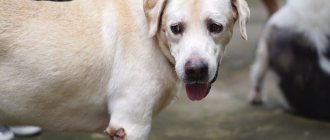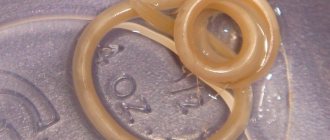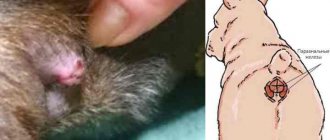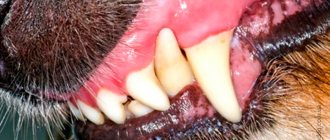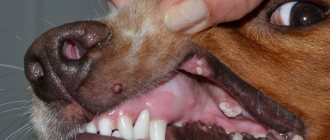How can you tell if your pet has a stomach ache?
Pain syndrome in a pet can be recognized by a number of signs. Among them:
- Severe anxiety. The pet may howl, whine, shake, and find no rest. Often an animal hides in remote places in an apartment or house so that the owner cannot find it. It can also take unnatural poses, often turn over, and make unnatural sounds.
- Decreased activity. Even a playful dog with stomach pain will refuse to play, take long walks, or train.
- Change in gait. A sick dog may limp or squat to reduce the discomfort experienced during movements.
- Nausea and vomiting after eating. The symptom may occur even when feeding proven safe food.
- Problems with stool: diarrhea, constipation, appearance of blood in the stool, mucus, change in color.
- Flatulence, a sharp increase in the size of the peritoneum. At the same time, the stomach itself becomes dense, tense, and growls.
- Intense thirst. It appears even in the cold season.
- Weakened response to external stimuli, drowsiness.
- Arrhythmia. Your pet may experience rapid breathing even with minimal physical activity.
- Painful sensations in the anal area. The dog may try to constantly bite the area under the tail and lick it.
- Increased salivation.
- Change in color of mucous membranes. They may turn blue.
- The appearance of spasms. They occur with a certain frequency and alternate with periods of calm.
- Lack of appetite. With severe pain, the pet may refuse even those treats that it usually eats very willingly.
The intensity of these symptoms depends on the type of pathology the pet suffers from. If his health problems are minor (for example, he has bloating due to eating poor quality food), the signs of pathology will be mild. In cases of severe disorders, the formation of tumors, or perforation of internal organs, the dog may experience severe pain and will not allow the owner to touch itself. She may experience a sharp increase in temperature and symptoms of fever.
A dog has a stomach ache: what should an owner do?
So, let's say the owner has every reason to believe that the animal has pain in the peritoneal area. What to do if your dog has a stomach ache? Will you be able to manage on your own? Or is it better not to hesitate, but to take the dog to the veterinary clinic as soon as possible? The opinion of most experts is that it is better not to carry out treatment at home, since it is unlikely that it will be possible to accurately determine the cause of the discomfort in the abdomen.
At the clinic, the doctor will first examine the animal, palpate its abdomen, prescribe blood, urine or feces for analysis, and possibly conduct an ultrasound and x-ray. And only after making the correct diagnosis will it be possible to prescribe the correct treatment. But what if your pet’s stomach hurts, and it’s impossible to get him to the clinic as soon as possible (after all, in the same outback you’re unlikely to find a 24-hour veterinary hospital)? You can do this:
- Lightly massage the dog's belly if it is not showing aggression;
- Give your pet a medicine that has antispasmodic and analgesic effects (No-Shpa, Buscopan, Spasmobrew);
- If there is a high degree of confidence that the dog could have been poisoned, it is worth giving it an enterosorbent (Atoxil, Enterosgel);
- If the dog is generally healthy, but has not relieved himself for several days, you can give a remedy for constipation (Vaseline oil, Duphalac).
That's probably all that can be done to improve the condition of your pet. But you will still have to see a doctor, because as we found out, abdominal pain can be caused, for example, by cancer tumors or foreign bodies that have entered the digestive organs. And in such cases, surgery will be necessary. And an infection or even pancreatitis cannot be cured with antispasmodics alone.
Why can dogs have stomach ache?
Now it’s time to decide for what reasons dogs may suffer from abdominal pain. So, the most common “culprits” of pain in the belly of your beloved pets are:
- Intestinal infection (for example, salmonellosis, colibacillosis, etc.);
Foreign objects stuck in the stomach or intestines;
Poisoning (spoiled food, rodent poisons, etc.);
Peritonitis (inflammation of the peritoneum);
Pancreatitis (inflammation of the pancreas);
Ascites caused by various reasons;
Diseases of the genitourinary system (renal failure, nephrolithiasis, cystitis, orchitis, prostatitis, etc.);
Worms that parasitize the gastrointestinal tract;
Poor diet (gas formation and abdominal pain can be caused by foods such as cabbage, peas, corn, sausages, etc.);
Digestive or liver cancer;
- An abrupt transfer of an animal to a new type of food (for example, when a dog, after porridge with meat, suddenly begins to be fed dry ready-made food).
Causes of colic and why your dog won’t let you touch its belly
In fact, specialists in such situations do not always begin by identifying the cause of the symptom. The fact is that in many situations it is much more important to relieve the pain first. It is also worth mentioning that in some situations the cause of spasms is not determined at all (when they are weak). In this case, most likely, the reason for their appearance was not serious. For example, an animal’s body could react in a similar way to a glass of cold water that did not contain any additives.
It is also worth mentioning hunger, which you should never bring your pet to. No, hunger will most likely not cause cramps, but they can appear from sudden and rapid eating. The dog will not eat in small portions and slowly, because if it wants to eat, it will quickly absorb even ordinary dry food, and in large quantities. This can lead to unpleasant consequences.
It is also worth noting volvulus, which is very typical for dogs, because it is quite easy to get it. In most cases, it can develop even due to the reasons that were just given. For this reason, for the dog’s safety, you should carefully monitor its entire diet: control the portion size yourself, make sure that it does not eat grass in large quantities (this is a natural process, you definitely shouldn’t scold the dog for this).
An important rule that will definitely help prevent the possibility of volvulus is that meals should be distributed throughout the day so that after them the dog rests and before them the same thing. Under no circumstances should you go for a walk at this time. Otherwise, the dog will definitely have serious health problems.
Also, do not forget about the existence of irritants. Practice shows that cases when various poisons or any irritating substances enter a dog’s body are not rare. There are a large number of dog owners who have lost interest in their pet or simply do not have the opportunity to play with them for a long time. This always leads to the animal looking for a way to have fun on its own. If your detergents are located on the lower shelves, then the chance that the dog will turn them over and swallow a little is quite high.
Symptoms and actions for abdominal cramps in a dog
Even experienced dog breeders often encounter dog health problems that baffle them, for example, sometimes the dog has abdominal cramps that are not always possible to recognize. The fact is that the animal cannot explain the essence of the problem, and even in those situations when you manage to determine the location of pain, it is quite difficult to understand the cause and nature of the pain. In such situations, you must immediately make an appointment with a veterinarian. This material has been prepared for informational purposes, and the problem that will now be discussed is precisely cramps in the abdominal area.
Types of colic in dogs
For ease of identification and treatment, there is a simple veterinary classification in which all these pathologies are divided into the following types:
- Colic is true, “canonical”. They occur only in diseases of the gastrointestinal tract (i.e. stomach and/or intestines).
- False group. These are colics that occur due to pathologies of the liver, gall bladder, kidneys, bladder, etc.
Veterinarians also divide true colic into categories. We will not delve into the jungle of classification: simple breeders only need to know that they are divided into gastric and intestinal.
- In the first case, colic is often caused by an expansion of the stomach (there can be many reasons for this).
- But intestinal colic is much more dangerous. They can also be divided into two groups: relatively simple, when the pathological condition is not accompanied by the development of peritonitis, and complex, when peritonitis has either already developed or there is a high probability of its occurrence.
Intestinal
Intestinal colic is one of the most dangerous. And it’s not even a matter of pain or spasms. This group of pathologies often leads to peritonitis, which is often fatal even if promptly consulted by a veterinarian.
The most dangerous are ileus (various pathologies leading to intestinal obstruction) and thromboembolism of the mesenteric veins (i.e. blockage of the veins of the mesentery of the intestines). In the first case, the intestines can mechanically rupture, in the second, they begin to rot due to lack of nutrition (and also subsequently rupture). All this is accompanied by terrible pain and spasms.
Hepatic
They fall into the category of false. But this does not mean that hepatic colic is easier. As a rule, they develop against the background of blockage of the bile ducts and the gallbladder itself.
The cause may be inflammation of a parasitic or infectious etiology, poisoning, or other negative factors. Such colics do not appear “out of the blue”; they are preceded by yellowing of the mucous membranes, sclera of the eye, and the appearance of an unpleasant, “chemical” odor from the animal’s mouth. In addition, during the same period, digestive problems develop, and the pet’s stool becomes pale.
Renal
At the same time, they belong to the category of “false” colic, but at the same time are considered one of their most severe and dangerous varieties. Renal colic occurs due to the formation of stones both in the kidneys themselves and in the ureters, bladder, as well as when small stones and sand get into the lumen of the urethra.
Colic of this type is characterized by attacks of unbearable, intolerable pain (according to the experience of people who have suffered them). Dogs have a bad time; animals with a sensitive nervous system can die from painful shock.
In addition, uremia often develops at this time (urine components enter the blood).
Gastric
This type belongs to the category of true ones. Typically, stomach colic in dogs is not very common and, for the most part, is mistaken for the intestinal variety. In addition, all true colic very often develops against the background of gastroenterocolitis, which often makes it impossible to draw clear boundaries between them.
The purely gastric type is more typical for poisoning when a dog drinks cold water immediately after training or after a long walk; sometimes this pathology affects dogs whose owners either overfeed their pets with bulky food that is useless for animals (potatoes, a lot of cereals, etc.) , or, on the contrary, they give them too much protein food (feeding dogs with meat alone is also extremely contraindicated).
How can you tell if your dog has a stomach ache?
Dogs are very patient creatures and in most cases they endure pain without showing any concern. Even if the dog is suffering from abdominal pain, he may not pay attention to it for a long time and behave as usual: eat, play and ask for a walk.
The animal only begins to whine pitifully and howl in pain when the painful sensations become truly unbearable and this is precisely the main danger. After all, by the time the owner notices that something is bothering the dog, the disease may have reached an extreme stage, which will significantly complicate its treatment.
If a dog has a stomach ache, it will whine and howl pitifully.
You can understand that something is bothering your pet only by carefully observing its behavior. There are several telltale signs that can help you determine if your dog is suffering from abdominal pain and cramps.
Symptoms
When palpating the abdomen, the dog will feel uncomfortable.
- Lack of appetite and weight loss . If a dog refuses to eat for no apparent reason and does not even react when the owner offers him his favorite treat, then this may be the first signal that he is having digestive problems.
- The pet has become lethargic and apathetic . The animal goes for a walk with its owner without much enthusiasm and does not show interest in a cat running past, or does not want to play with its favorite ball.
- Evidence that the dog is sick can be the sign that he suddenly began to feel fear of people and is afraid to go outside at all . At the same time, the dog looks for a secluded place in the house and tries to hide in it from everyone.
- Sudden aggression towards the owner is also a symptom that the dog has health problems. If a friendly and affectionate pet does not allow the owner to approach him and even tries to bite him, then perhaps he is suffering from abdominal pain and this is what caused his irritability and aggressive behavior.
- The owner should pay close attention to the chair of his four-legged friend. Constipation or diarrhea may indicate problems with the gastrointestinal tract.
- Vomiting after each meal can also be a sign of a digestive system disease. In this case, an unpleasant and putrid odor from the pet’s mouth often appears.
- The dog's gait changes . He walks hunched over, raising the back of his body and whining at the same time.
How to protect your pet from stomach pain
Of course, you won’t be able to protect your dog 100% from stomach pain. But every owner can reduce the risk of developing such an unpleasant pathology to a minimum:
- The dog’s menu should not contain potentially dangerous foods (sweets, flour, smoked, spicy, fried, etc.). It is also better to avoid cheap economy class food;
Worms are often the cause of pain in the peritoneum. It is necessary to give the dog deworming medications once a quarter;
It is important to monitor what your tailed pet puts in its mouth. Many dogs suffer from pain caused by a foreign object lodged in the stomach or intestines. So, it is important to test all dog toys for durability. During the walk, you will have to be vigilant so that the dog does not tear or gnaw bones buried in the ground;
It is necessary to monitor the frequency and consistency of your pet's stool. Is the color of the stool unusual (almost black, green, whitish, etc.)? You need to go to the doctor as soon as possible, as in cases where there is diarrhea or constipation;
Any sign of ill health other than abdominal pain (for example, refusal to eat, fever, urge to vomit, lethargy, etc.) is a reason to contact the clinic. Many diseases are easier to treat the earlier the diagnosis is made. In general, it is advisable to show even a healthy dog to the doctor at least once a year for preventive purposes;
- It is important to control the size of your pet's portions. Unfortunately, sometimes dogs suffer from abdominal pain due to banal overeating.
source
Diagnostics
An animal with abdominal pain is treated with:
- Ultrasound
to examine the abdominal organs. Ultrasound can detect the following diseases: pyometra, - suspicion of a foreign object in the gastrointestinal tract (the method is not expert, but a section of the intestine with reduced peristalsis can be detected),
- inflammatory process in the intestines,
- impaired renal structure in chronic renal failure in dogs, polycystic kidney disease, kidney tumors,
- cystitis, bladder overflow, bladder stones,
- splenomegaly, hepatomegaly (increase in the size of the spleen and liver, respectively),
- intestinal tumors,
- free fluid in the abdominal cavity,
- suspicion of fecal stones (coprostasis),
- swelling in the pancreas, abscess, pancreatic cysts.
. An x-ray may show:
- foreign body in the gastrointestinal tract,
. Blood tests are taken (clinical and biochemical, coagulogram). Blood tests evaluate:
- work of the kidneys, liver, pancreas,
.
- for plague, parvovirus, protozoa, coronavirus enteritis.
.
- general urinalysis and protein/creatinine ratio analysis for renal failure,
from the abdominal cavity (if present).
- to diagnose the tumor process, the fluid is submitted for cytological analysis,
Preventive measures
To prevent stomach pain in your pet, follow these rules:
- Carry out preventive immunization and deworming of your pet in a timely manner. This will prevent the development of gastrointestinal diseases.
- Give your dog a nutritious, balanced diet. Introduce a variety of foods into it. In order not to make a mistake in choosing a menu for your pet, contact your veterinarian for help in this matter.
- Give your dog only high-quality food. Under no circumstances should you offer him foods that are too fatty, expired, spoiled foods, or rotten fruits and vegetables. Avoid highly salted and peppered treats. This is very dangerous for his health.
- Make sure your pet always has clean drinking water in his bowl. It is especially important to pay attention to this in the warm season.
- Stick to a strict diet. Try to feed the animal at the same time with the same portions. Make sure that it does not overeat and does not remain hungry after a meal.
- Make sure that the animal does not pick up foreign objects from the ground during walks. Remember that they can be dangerous for the pet.
- Make sure that the animal does not fall from the furniture or receive blows to the peritoneal area. This can lead to the development of tumors, damage to internal organs, and bleeding. This often occurs in small breed dogs. Such individuals are more susceptible to various injuries.
If you know that your pet has a predisposition to gastrointestinal diseases, contact a veterinary clinic in a timely manner and undergo regular preventive examinations. Remember: many diseases of the stomach and intestines are much easier to treat in the early stages, when they are asymptomatic and can be controlled with a special diet.
Causes
To help your dog get rid of abdominal pain, it is necessary to determine the cause of its occurrence. After all, the problem can be either mild food poisoning and poor nutrition, or more serious diseases, for example, infection entering the body or the formation of a tumor in the abdominal cavity.
Causes of abdominal pain:
- Poor quality food . Sometimes changing your usual brand of food can cause problems with the digestive system.
- Entry into the stomach of a foreign body . The dog can swallow a small object, which causes cramps and sharp pain in the abdomen.
- The cause of pain in the abdominal cavity also lies in the entry of an intestinal infection . This can be determined by signs such as diarrhea or the presence of blood clots in the dog’s stool.
- If the dog was hungry and greedily attacked the food offered , then he may subsequently suffer from cramps in the abdominal cavity.
- Damage to internal organs due to injury can also cause abdominal pain.
- Presence of parasites . Infection with helminths is one of the most common causes of pain and cramps in the abdominal cavity.
- With pancreatitis (inflammation of the pancreas), the dog experiences severe pain in the abdomen, loses appetite and becomes lethargic.
- Another cause of pain can be poisoning . This happens if a pet eats stale food thrown away by someone on the street.
- Some foods (legumes, corn or pearl barley) can cause colic and increased gas production, so it is not advisable to include them in your dog’s diet.
- In some cases, the causes of acute abdominal pain are inflammation of the genitourinary system or cystitis.
- Your pet may have stomach pain due to the formation of a tumor in the stomach or intestines .
Poor quality food can cause stomach pain.
When to sound the alarm?
If the cause of cramps and pain in the abdominal cavity is poor nutrition or poor quality food, then after changing the diet everything will return to normal in a few days and in this case there is no need for long-term treatment.
But if the owner notices that the pet is suffering from periodic abdominal pain, and when trying to touch this part of the body, it whines and even growls at the owner , the animal should be taken to a veterinary clinic. After all, such symptoms may indicate a serious illness and cannot be avoided without the help of a qualified specialist.
If a dog growls when its belly is touched, then you need to take it to the veterinarian.
Do not forget that the dog’s health and well-being depend on an accurate diagnosis and timely treatment.
Recommendations
In order not to encounter all the problems listed above in the future, it is recommended to monitor the dog’s toys, monitor its nutrition, and maintain a balance in the diet. It is recommended that animals not used for breeding be sterilized to prevent the development of pyometra in the future. Puppies must be vaccinated from the age of eight weeks, quarantine after purchasing a new animal, and limit contact with stray dogs. It is recommended to bring pets over seven years of age to the veterinary clinic for examination and medical examination once a year.
Sources
- https://teatrzoo.ru/bolit-zhivot-u-sobaki.html
- https://DogCatFan.com/471-u-sobaki-bolit-zhivot.html
- https://RealPet.ru/zdorovie/spazmy-zhivota-u-sobaki.html
- https://mykoshka.ru/bolit-zhivot-u-sobaki-chto-delat/
- https://vashipitomcy.ru/publ/sobaki/lechenie_i_profilaktika/kak_ponjat_chto_u_sobaki_bolit_zhivo_priznaki_simptomy/25-1-0-2412
- https://zoostatus.ru/lechenie/simpromy/bolit-zhivot-u-sobaki/
- https://dogworry.ru/veterinariya/u-sobaki-bolit-zhivot-chto-delat.html
[collapse]




